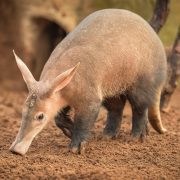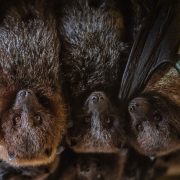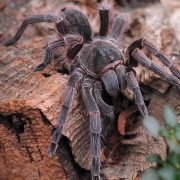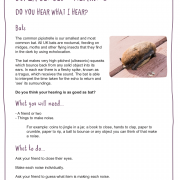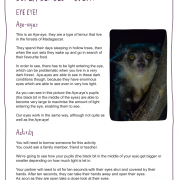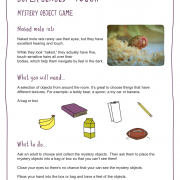There are some fascinating creatures that are active at night. Enter the world of nocturnal animals to discover how they find their way around their environment, hunt and evade predators.
For all animals, there are three common necessities of life: finding food, finding a mate and avoiding being eaten. But some face the extra challenge of having to do all of that in the dark!
As humans we rely heavily upon our sense of sight, so we are going to explore the ways other animals have become adapted to life where there is a lot less light! Follow our step by step guide to investigate the world of nocturnal animals and find out how these amazing creatures use their super senses to navigate life in the dark.
STEP ONE: WHAT ARE NOCTURNAL CREATURES?
Begin by introducing the theme, nocturnal animals, and explore what the learners already know about the topic. Ask your learners if they can name any nocturnal animals and to think about animals that they may have seen at night.
Use our nocturnal animal fact files to discover more about the different species of animals that are active at night.
Download our: Nocturnal Animals Fact File Collection
To make things a bit more playful, why not have a game of Nocturnal Creatures Bingo where you can learn about some more animals that are active at night. See if you can work out which ones are and which ones aren’t so you can shout BINGO before the other players!
Play our: Nocturnal Creature Bingo
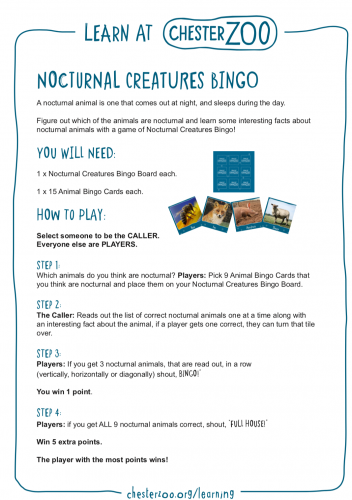
Make a record of what you’ve found out using our writing sheet.
Use our: Nocturnal Creatures Writing Sheet
For some extra help familiarising yourself with these new words we have put together a glossary and word search.
Download our: Nocturnal Creatures Word Search & Glossary
- Have a go at writing a poem about your favourite nocturnal animal
- Create your own fact file or poster
- Create a quiz to test someone else about nocturnal creatures using the facts you’ve discovered
STEP TWO: SUPER SENSES!
Animals active at night depend on more than their vision to know what is happening in their surroundings. Nocturnal animals have at least one highly developed sense. Special adaptations include big ears, large eyes, sensitive whiskers and keen noses.
We have five senses, do you know what they are?
Sight, hearing, smell, taste and touch.
We are going to go through some of these senses with you and see some of the nocturnal animals which use them.
We’ve created some activities to try out and test your own senses!
Download our: Super Senses Collection
Now you’ve explored some of the amazing adaptations used by animals to survive at night, it’s time to use your knowledge to design your own nocturnal animal.
Try out our: Draw your own Nocturnal Creature
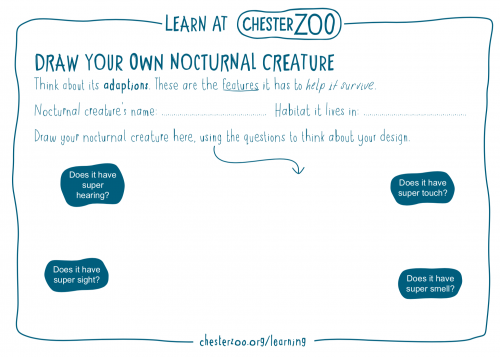
- Create a Super Senses Story with your own nocturnal creature as the main character
- Write a poem about what the world is like for animals that are awake in the dark
- Invent something that would enhance one of your own senses, like sound enhancing headphones or night vision goggles.
STEP THREE: NOCTURNAL CREATURES AT HOME
When the sun is out, your garden or school grounds can be full of wildlife including bees, birds and butterflies. But once the sun goes down and we head indoors, a new world of wildlife wakes up and takes over your outdoor space. It’s time to be a night time wildlife detective!
Looking for footprints can help us identify the different animals that might be visiting our gardens or school grounds at night. Use our video guide to learn how to create your own footprint tunnel and collect footprints from the animals that might be traveling through your spaces at night.
Download our: How to build a footprint tunnel collection
If you need some help identifying which footprints belong to which animal, we’ve created a useful ID sheet.
Use our ID sheet: Who has been visiting my garden?
Bats are amazing nocturnal creatures. many of which use echolocation as their way of ‘seeing’ the world. To attract bats to your garden or school, try making a bat box to put up somewhere high.
Download our: How to make a Bat Box Collection
If you’d like to attract other UK nocturnal animals have a watch of this:
